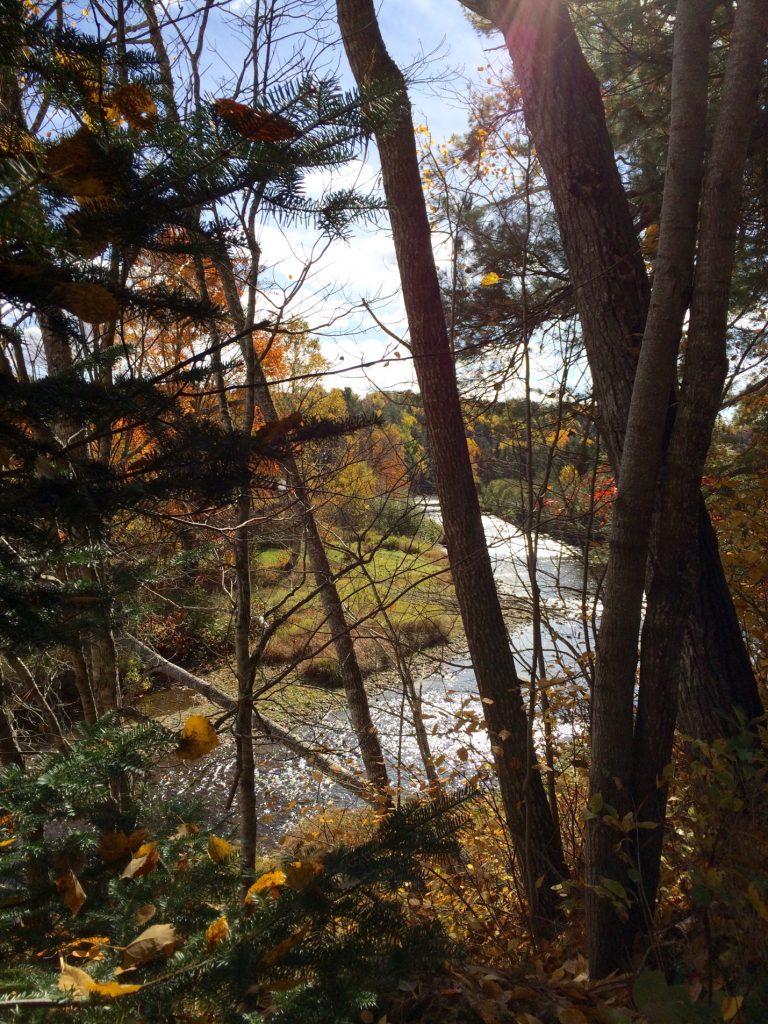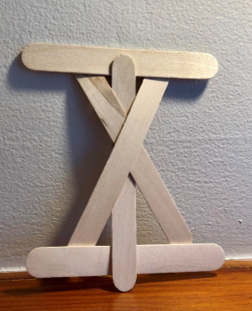Materials required: paper, coloured markers or crayons
As an introduction to this lesson, read the story by Rita Joe below, while the children are looking at the Creek at Wilson Road photo below.

At the end of the story, ask students to first discuss Rita Joe’s emotions:
- Why was she lonely?
- Was this story based on Rita Joe’s own experience?
- Why did she believe that there is life everywhere?
- How does this story make you feel?
- Have you experienced anything like Rita experienced?
Ask them to say the title of this activity aloud and explain that this is what Rita Joe is describing.
There is Life Everywhere
Introduction
The ever-moving leaves of a poplar tree lessened my anxiety as I walked through the woods trying to make my mind work on a particular task I was worried about. The ever-moving leaves I touched with care, all the while talking to the tree. ‘Help me,’ I said. There is no help from anywhere.
This moving story I want to share. There is a belief that all trees, rocks, anything that grows is alive, helps us in a way that no man can ever perceive, let alone even imagine. I am a Mi’kmaw woman who has lived a long time and know which is true and not true — you only try if you do not believe — I did, that is why my belief is so convincing to myself.
Story
There was a time when I was a little girl, my mother and father had both died. I was living at yet another foster home which was far away from a native community. The nearest neighbours were non-native, and their children never went near our house, though I went to their school and got along with everybody, they still did not go near our home. It was at this time I was so lonely and wanted to play with other children my age which was twelve at the time. I began to experience unusual happiness when I lay on the ground near a brook just a few metres from our yard. At first, I lay listening to the water: it seemed to be speaking to me with a comforting tone, a lullaby at times. Finally, I moved my playhouse near to it to be sure I never missed the comfort from it. Then I developed a friendship with a tree near the brook. The tree was just there. I touched the outside bark, the leaves I did not tear but caressed. A comfortable feeling spread over me like warmth, a feeling you cannot experience unless you believe. That belief came when I was saddest. The sadness did not return after I knew that comfortable unity I shared with all loving animals, birds, even the well I drew the water from. I talked to every bird I saw; the trees received the most hugs. Even today, others do not know the unconditional freedom I have received from the knowledge of knowing that this is possible. Try it and see. There is life everywhere, treat it as it is, it will not let you down.
Rita Joe, Eskasoni
- Ask students if they have any questions about this story. What does it mean to them and have they ever felt this way?
- Have students create an individual chart of the following. Using simple drawings, have students make a ‘picture-web’ (symbols) of the responses around the concept KMIMAJUAGNMINAL — ALL LIVING THINGS ARE RELATED — PSONAKUTOMUWAKON.
Have students use a lot of arrows to show how things relate back to one another. While drawing, have students use a variety of colours and markers to emphasize their reactions to the questions below.
- Have you ever walked through the woods along a river, stream or lake with a friend, parent, or grandparent?
- What is your favourite memory of walking there?
- Did you collect anything to bring home? What did you do with it?
- Can you remember if there were things to eat along the way? Or things to make other things from?
- Have you ever caught a snake? Tadpoles? Minnows?
- Did you: Go fishing? Pick wild berries? Collect rocks? Pick flowers?
- Did it matter what season it was? Why?
- What sounds do you remember? Smells? What feelings did you have?
- What was the most beautiful part of your time in nature?
- Were you happy? Confused? Curious? Excited? Afraid?
- Did you have permission to be there? Were there rules about how you were supposed to act?
- Are the places that you walked still there, or have they changed? Why?
- Is there anything special that you remember about your experience?
Math – Create a chart/grid/table as a model and ask students to identify and explain the patterns that can be found on their own chart/grid/table. Include on the chart the students’ responses regarding the senses: see, hear, smell, touch, taste.
Science and Language Arts – While exploring and discussing plants and animals that live in their local habitats, students should realize the impact they can have on the environment. Summarize by asking the following questions:
- How do you treat the organisms (animals and plants) you encounter?
- Do you make sure you do not leave behind any garbage?
- What small steps can you take near your home to see that habitats are preserved and protected?
Or demonstrate with popsicle sticks (5 per student). Label them: shelter, food, habitat, protection of all things, and clean water. Then have students connect them together to form a WEB OF LIFE by placing 3 popsicle sticks in a V shape and weaving a popsicle stick from left to right at midpoint. With the last one, weave it around the top. It should self-support in a wigwam shape until one stick is removed. Then the structure will fall apart. Close the lesson with a discussion on the impact of climate change on the WEB OF LIFE.

Then have the students summarize their feelings about these senses and write a code or a rule to follow about their reactions to living things. Post this on the wall and call it KMIMAJUAGNMINAL — ALL LIVING THINGS ARE RELATED — PSONAKUTOMUWAKON.





